By Sharon Pritchard –
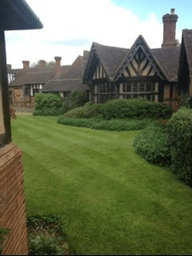 Originally a country house built in the 12th century, Hever Castle in Kent was home to Anne Boleyn, the unfortunate second wife of Henry VIII, after her father, Thomas Bullen inherited it in 1505.
Originally a country house built in the 12th century, Hever Castle in Kent was home to Anne Boleyn, the unfortunate second wife of Henry VIII, after her father, Thomas Bullen inherited it in 1505.
The castle houses antique furniture, instruments of torture, Anne Boleyn’s prayer books and a fine collection of original artwork. The castle is reputed to have the oldest working portcullis in England.
It was an American, William Waldorf Astor after purchasing the castle in 1903 , who is responsible for the renovation and preservation of much of the Tudor features that visitors enjoy today. The beautifully landscaped gardens include a maze of magnificent yew trees, a rose garden and a lake. Jousting tournaments are regularly held here during the summer months attracting large numbers of visitors to Hever.
It was with great anticipation that I arrived at the Astor Wing of Hever Castle which offers 18 individually designed, luxurious bedrooms. This wing of the castle is only open to private guests and not the general visitors to the gardens and castle. The surrounding countryside of 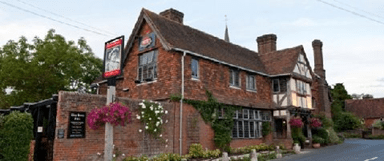 Kent, known as “The Garden of England” is lush, green and tranquil and as I drove to the grand entrance gates it was as if I was being transported back in time as the gates smoothly opened revealing the long driveway approach to the Tudor Village.
Kent, known as “The Garden of England” is lush, green and tranquil and as I drove to the grand entrance gates it was as if I was being transported back in time as the gates smoothly opened revealing the long driveway approach to the Tudor Village.
Anne Boleyn was executed for treason and adultery and it is said that her ghost walks the hallways of Hever Castle and she has been seen by staff and visitors on many occasions. Although an avid lover of the Tudor Period, I was not altogether eager to meet the unfortunate lady during my stay and was pleased to find that my room was on ground floor with an exit door close by!
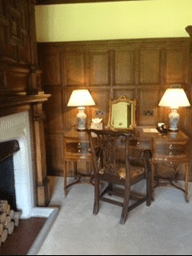
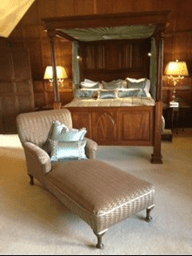 Although the furnishings compliment the Tudor style building, there are contemporary touches expected by modern-day guests. All rooms have en-suite facilities, the essential tea/coffee making facilities and a TV. Lounge areas are beautifully styled with many intricate touches and thickly carpeted corridors lead to a variety of paneled nooks where one can relax, read or dream.
Although the furnishings compliment the Tudor style building, there are contemporary touches expected by modern-day guests. All rooms have en-suite facilities, the essential tea/coffee making facilities and a TV. Lounge areas are beautifully styled with many intricate touches and thickly carpeted corridors lead to a variety of paneled nooks where one can relax, read or dream.
Although the Astor Wing offers no dining facilities apart from breakfast, there is a traditional pub within walking distance aptly named The Henry VIII. A truly historic English pub with open fires, oak-beamed ceilings and paneled bars, this place is a gem! Food portions are generous and well presented. My choice for the evening was a whole baked Camembert served with red onion chutney and a warm baguette (yes, I know it’s French but we don’t get chutney in France!) followed by slow roasted belly of pork with black pudding mashed potatoes and cider and apple gravy. Dessert was by-passed after that lot and I was glad of the walk back to Hever Castle!
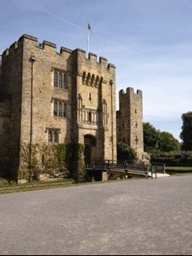 Thankfully, I had no transparent night visitors with a head tucked underneath her arm and after a traditional English breakfast of eggs, bacon, sausage, mushrooms, tomatoes, black pudding and fried bread, I returned reluctantly to the 21st century feeling rested, relaxed and extremely full!
Thankfully, I had no transparent night visitors with a head tucked underneath her arm and after a traditional English breakfast of eggs, bacon, sausage, mushrooms, tomatoes, black pudding and fried bread, I returned reluctantly to the 21st century feeling rested, relaxed and extremely full!
Kentish Apple Chutney – the perfect accompaniment to meats, cheeses, cold cuts
Kent produces many varieties of apples and this chutney can be made with any variety you wish. I have used the sharper Granny Smith apple and also the sweeter Braeburn and both were equally good.
This recipe will make approximately three 1-pound jars
2 pounds apples
1 pint of spiced pickling vinegar
1 pound sugar
1 teaspoon salt
1 teaspoon Allspice
1 tablespoon grated fresh ginger
12 ounces sultanas (golden raisins)
Peel core and chop the apples. Put vinegar, salt, sugar and allspice into a pan bring to the boil until sugar has dissolved then add the apples and ginger. Simmer for 10 minutes. Add the sultanas and simmer gently until mixture thickens. Allow the chutney to cool a little before putting into clean sterilized jars. This chutney is best eaten 4-6 weeks after making.
F&M
